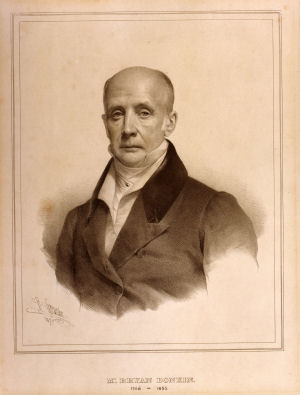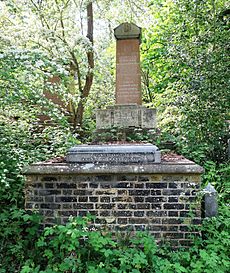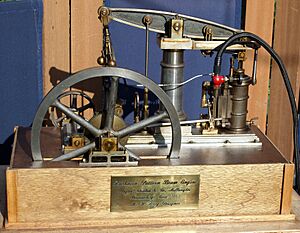Bryan Donkin facts for kids
Quick facts for kids
Bryan Donkin
|
|
|---|---|
 |
|
| Born | 22 March 1768 |
| Died | 27 February 1855 (aged 86) Bermondsey, London
|
| Resting place | Nunhead Cemetery |
| Known for | Paper making machine and canning process |
| Spouse(s) | Mary Brames |
| Children | 11 |
| Parent(s) | John Donkin and Jane Soppitt |
Bryan Donkin (FRS FRAS) was a brilliant engineer and inventor. Born on March 22, 1768, he made amazing contributions that shaped modern industries. He developed the first machine to make paper continuously. He also opened the world's first factory for canning food.
Donkin worked on huge projects with famous engineers like Thomas Telford and Marc Brunel. He even helped Charles Babbage with his early computer designs. Bryan Donkin was highly respected and advised the government. His inventions still impact our lives today.
Contents
Early Life and Engineering Start
Bryan Donkin grew up in Sandhoe, Northumberland, England. His father was a surveyor, which meant he measured land. Bryan first followed in his father's footsteps.
In 1792, Donkin wanted to become an engineer. He asked a famous engineer, John Smeaton, for advice. Smeaton told him to train with John Hall at the Dartford Iron Works. After his training, Donkin started his own business in Dartford. He made molds for paper factories, as paper was still made by hand back then. In 1798, he married Mary Brames. Her sister was married to John Hall, making them brothers-in-law.
Amazing Inventions and Ideas
Bryan Donkin was a true innovator. He created machines that changed how many things were made.
Making Paper Easier
In 1801, Donkin began working on a new idea. He took an early version of a machine that could make paper in a continuous roll. He improved it greatly, turning it into the famous Fourdrinier machine. This machine is the basis for how paper is made even today!
In 1802, Donkin opened his own company in Bermondsey, London. By 1804, he had a working paper machine. The next year, he made an even better one. By 1810, eighteen of these complex machines were being used in different paper mills. Donkin's company continued to build these machines. By 1851, they had made almost 200 machines for use all over the world.
Cool Printing Technology
Donkin also worked on machines for printing. In 1813, he and a printer named Richard Bacon invented a "Polygonal printing machine." This machine used types (letters) placed on a spinning roller. It was one of the first machines to use special ink rollers. These new rollers were much better than the old ones made of leather. Donkin's ink roller quickly became the standard for the printing industry.
Food That Lasts: Canning
Donkin became very interested in preserving food in metal containers. In 1812, his brother-in-law, John Hall, bought a patent for this idea. After many tests, Donkin, Hall, and a partner named Gamble opened a canning factory in Bermondsey. This was the first factory to use tinned iron containers for food.
By 1813, they were selling preserved food to ships leaving port. Soon, the British Admiralty (the navy) was ordering large amounts of canned meat. The company, Donkin, Hall and Gamble, later became part of Crosse & Blackwells, a well-known food company. You can see one of Donkin's early tin cans at the Science Museum, London.
Helping Build Early Computers
In the 1820s and 1830s, the famous inventor Charles Babbage asked Donkin for help. Babbage was trying to build his "difference engine"—an early mechanical computer. Donkin helped sort out problems with the manufacturing of the machine.
Bryan Donkin retired from his active role in the business in 1846. He was 78 years old. His sons, John, Bryan, and Thomas, continued to run the company.
Later, in 1857, the British government asked Donkin's company to build a full-sized difference engine. This machine was based on designs by Per Georg Scheutz and his son. Donkin's company was known for making machines that printed banknotes and stamps. The machine was delivered in 1859. It could work with 15-digit numbers and print its results, just as Charles Babbage had imagined. This important machine is now at the London Science Museum.
Building Big Things
Bryan Donkin's company often supplied machinery for large construction projects. He was also an important advisor.
Underground Tunnels
In the 1820s, Donkin became a director of the Thames Tunnel Company. He had met Marc Brunel, the tunnel's engineer, before. From 1825 to 1827, Donkin supplied powerful pumps to remove water from the tunnel. He also sent workers to help improve the tunnelling shield, a special device used to dig safely.
Canals and Waterways
Donkin's company regularly provided machines for civil engineering. For example, they built dredging machines (which clear mud from waterways). They made these for the Caledonian Canal in Scotland in 1816. They also supplied them for canals in Prussia (Germany) and Sweden. His company also provided steam engines to help build the locks on the Caledonian Canal.
As a respected engineer, Donkin was often asked for his opinion. He supported Thomas Telford's idea for a huge suspension bridge at Runcorn in 1814. He also helped Telford survey rivers in London for a water supply report.
Other Clever Ideas
Donkin had many other inventions and contributions.
In 1820, he worked with Sir William Congreve to prevent the forgery of excise stamps. They used a special method of two-color printing. This machine was used by the government and the Honourable East India Company. This "Rose Engine" machine is also now at the Science Museum, London.
By 1847, Donkin's company started designing products for the new gas industry. Today, the name Donkin is still used for certain gas valves.
Among Donkin's other inventions were a machine for cutting screws and a device to measure how fast machinery was spinning. He also invented a counting machine. The last two inventions won awards from the Royal Society of Arts.
A Legacy of Innovation
Bryan Donkin was a key figure in many important scientific and engineering groups.
In 1805, he helped form the Society of Master Millwrights. He was also a member of the Royal Society of Arts. He became a vice-president and led its Committee of Mechanics.
In 1838, he was elected a fellow of the Royal Society, a very high honor for scientists.
Donkin was one of the founders and a vice-president of the Institution of Civil Engineers. This group was started by one of his students, Henry Robinson Palmer. Donkin even helped the institution get its special royal charter in 1828.
He was also a founder of the Royal Astronomical Society and served on its council.
His Final Years
Bryan Donkin passed away at his home in London on February 27, 1855. He was 86 years old. He was buried in a family vault at Nunhead Cemetery in south London. His wife, Mary, and other family members were later buried there too.



